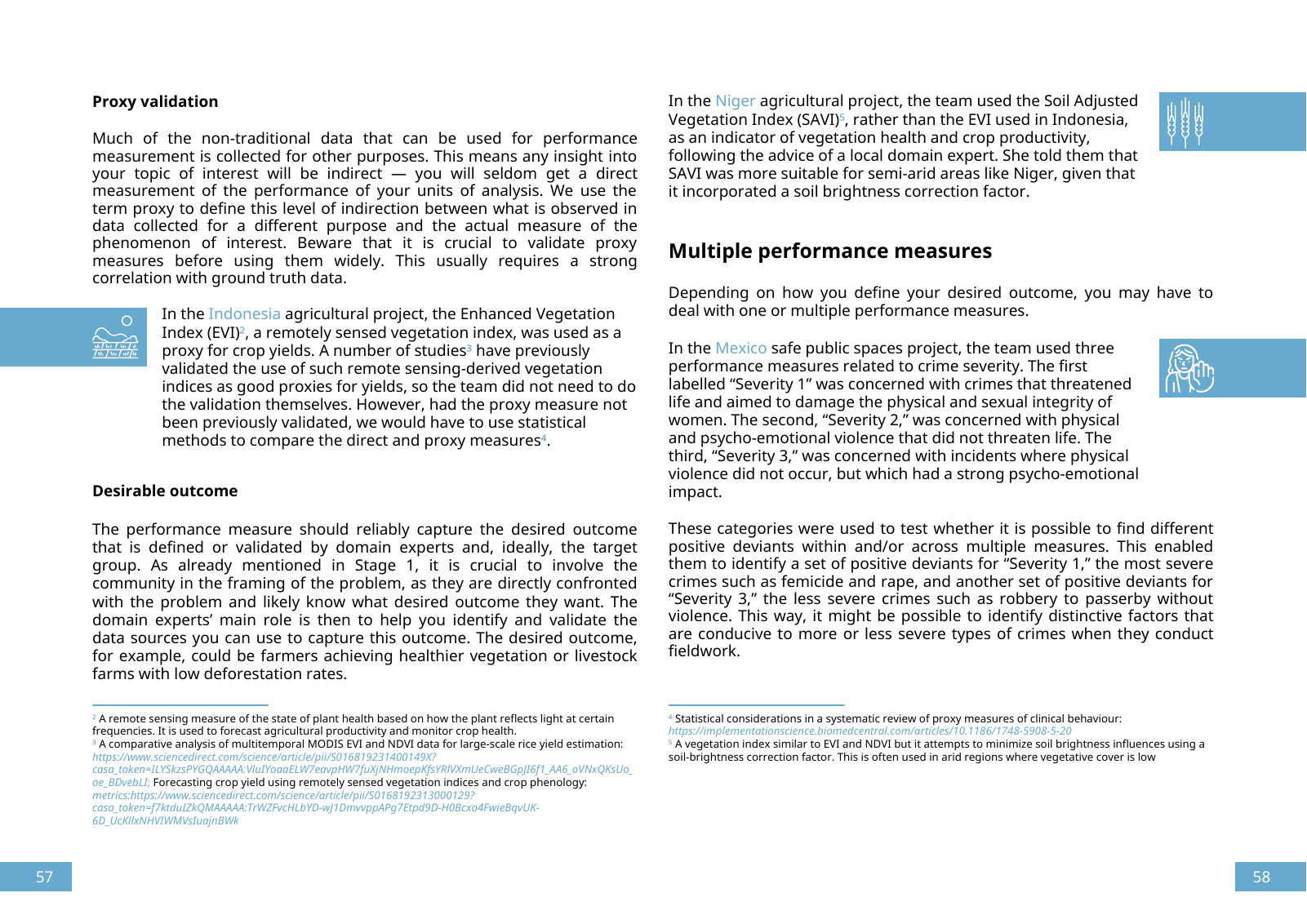A remote sensing measure of the state of plant health based on how the plant reflects light at certain frequencies It is used to forecast agricultural productivity and monitor crop health A comparative analysis of multitemporal MODIS EVI and NDVI data for large scale rice yield estimation https www sciencedirect com science article pii S016819231400149X casa token ILYSkzsPYGQAAAAA VluIYoaaELW7eavpHW7fuXjNHmoepKfsYRlVXmUeCweBGpJI6f1 AA6 oVNxQKsUo oe BDvebLI Forecasting crop yield using remotely sensed vegetation indices and crop phenology metrics https www sciencedirect com science article pii S0168192313000129 casa token f7ktduIZkQMAAAAA TrWZFvcHLbYD wJ1DmvvppAPg7Etpd9D H0Bcxo4FwieBqvUK 6D UcKllxNHVIWMVsIuajnBWk Proxy validation Much of the non traditional data that can be used for performance measurement is collected for other purposes This means any insight into your topic of interest will be indirect you will seldom get a direct measurement of the performance of your units of analysis We use the term proxy to define this level of indirection between what is observed in data collected for a different purpose and the actual measure of the phenomenon of interest Beware that it is crucial to validate proxy measures before using them widely This usually requires a strong correlation with ground truth data In the Indonesia agricultural project the Enhanced Vegetation Index EVI a remotely sensed vegetation index was used as a proxy for crop yields A number of studies have previously validated the use of such remote sensing derived vegetation indices as good proxies for yields so the team did not need to do the validation themselves However had the proxy measure not been previously validated we would have to use statistical methods to compare the direct and proxy measures Desirable outcome The performance measure should reliably capture the desired outcome that is defined or validated by domain experts and ideally the target group As already mentioned in Stage 1 it is crucial to involve the community in the framing of the problem as they are directly confronted with the problem and likely know what desired outcome they want The domain experts main role is then to help you identify and validate the data sources you can use to capture this outcome The desired outcome for example could be farmers achieving healthier vegetation or livestock farms with low deforestation rates In the Niger agricultural project the team used the Soil Adjusted Vegetation Index SAVI rather than the EVI used in Indonesia as an indicator of vegetation health and crop productivity following the advice of a local domain expert She told them that SAVI was more suitable for semi arid areas like Niger given that it incorporated a soil brightness correction factor Multiple performance measures Depending on how you define your desired outcome you may have to deal with one or multiple performance measures In the Mexico safe public spaces project the team used three performance measures related to crime severity The first labelled Severity 1 was concerned with crimes that threatened life and aimed to damage the physical and sexual integrity of women The second Severity 2 was concerned with physical and psycho emotional violence that did not threaten life The third Severity 3 was concerned with incidents where physical violence did not occur but which had a strong psycho emotional impact These categories were used to test whether it is possible to find different positive deviants within and or across multiple measures This enabled them to identify a set of positive deviants for Severity 1 the most severe crimes such as femicide and rape and another set of positive deviants for Severity 3 the less severe crimes such as robbery to passerby without violence This way it might be possible to identify distinctive factors that are conducive to more or less severe types of crimes when they conduct fieldwork Statistical considerations in a systematic review of proxy measures of clinical behaviour https implementationscience biomedcentral com articles 10 1186 1748 5908 5 20 A vegetation index similar to EVI and NDVI but it attempts to minimize soil brightness influences using a soil brightness correction factor This is often used in arid regions where vegetative cover is low 57 58

Hinweis: Dies ist eine maschinenlesbare No-Flash Ansicht.
Klicken Sie hier um zur Online-Version zu gelangen.
Klicken Sie hier um zur Online-Version zu gelangen.